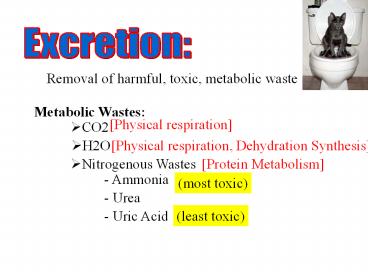Excretion: - PowerPoint PPT Presentation
1 / 28
Title:
Excretion:
Description:
Removal of harmful, toxic, metabolic waste Metabolic Wastes: [Physical respiration] CO2 H2O [Physical respiration, Dehydration Synthesis] Nitrogenous Wastes – PowerPoint PPT presentation
Number of Views:95
Avg rating:3.0/5.0
Title: Excretion:
1
Excretion
Removal of harmful, toxic, metabolic waste
Metabolic Wastes
Physical respiration
- CO2
- H2O
Physical respiration, Dehydration Synthesis
- Nitrogenous Wastes
Protein Metabolism
- Ammonia
(most toxic)
- Urea
- Uric Acid
(least toxic)
2
Organs Involved
Skin
Lungs
Liver
Kidneys
3
What are the 4 major organs involved with
excretion
Liver
Skin
Kidneys
Lungs
Work together to maintain homeostasis
4
Physical Respiration
Exchange of gases (CO2, H2O, O2)
Pathway of air
Nasal Passage
Pharynx
Larynx
Trachea
Bronchi/Bronchial tubes
Bronchioles
Alveoli
(respiratory surface)
LUNGS
150 million per lung
5
Nasal Passage
Pharynx
Larynx
Trachea
Bronchi
Lung
Bronchial Tubes
6
Nasal Passage
1) Hairs filter out large foreign particles
2) Mucus on walls trap bacteria and dust
3) Moistens air
4) Blood moving through capillaries warm inhaled
air
Pharynx
Connects oral cavity to nasal passage
Larynx
(Voice Box)
Between pharynx to trachea
7
Trachea through Bronchial tubes
- transports air to alveoli
- walls produce mucus to trap bacteria and dust
- cilia line walls and beat mucus upwards
8
Alveoli
- Are thin, moist and surrounded by capillaries
- Are the functional units for gas exchange between
the lung and the blood - Alveoli increase surface area for gas exchange
- O2 diffuses into the blood from the alveoli and
CO2 and water diffuse out of the blood and into
the alveoli
9
Bronchial Tube
10
Alveoli
Bronchiole
11
(II) Breathing Process
12
What part of the brain controls breathing?
(involuntary behavior)
Medulla
To what is the medulla responding?
Carbon Dioxide concentration in the blood
13
Effects of Smoking
- paralyzes cilia in the
- respiratory tract
- increases production of
- mucus (smokers cough)
- smoke particles eventually break down alveoli
wall - forming scar tissue. Lungs lose elasticity
becoming - less functional
- Smoke contains carcinogens (cause lung cancer)
14
Healthy Lung Tissue
Diseased Lung Tissue
15
Disorders of the Respiratory System
Asthma
- Severe allergic response
- Contraction of bronchioles
- making breathing difficult
- Fatigue
Bronchitis
- inflammation of the lining of the bronchial
tubes
- results in a severe cough and difficulty
breathing
- fatigue
16
Emphysema
- lungs lose elasticity
- results in shortness of breath, difficulty
breathing
- fatigue
Pneumonia
- alveoli become filled with fluid
- prevents exchange of gases at alveoli
- severe cough, chest pain
- fatigue
17
Lung Cancer
- tumors form in lungs (irregular uncontrolled
cell - growth)
- lungs lose elasticity, breathing difficulty
- fatigue (eventually death)
18
Liver
Regulates body fluid composition
- Detoxification of blood
- Synthesis of bile
- Urea formation (amino acid break down)
19
Skin
Epidermis
Dermis
Sweat Gland
Hair Follicle
Nerve
Sebaceous Gland
Fatty Tissue
20
Sweat Glands
- Release perspiration
- Sweat contains water, urea and salt
Functions
- Excretion
- Regulation of body temperature
21
Video 2
Video 2
Kidney Function
- Click the image to play the video segment.
22
Kidneys
Functions
- Remove metabolic waste from the blood
- Salt, urea, (water)
- Regulates composition of body fluids
- Control concentration by eliminating/holding
- onto water
Nephron
(functional unit)
- 1.25 million per kidney
23
(No Transcript)
24
Path of Urine Excretion
Kidney
Ureters
Urinary Bladder
Urethra (boys and girls both have!)
25
How do the kidneys maintain homeostasis? (How do
the kidneys regulate blood/urine
composition?) During exercise After
drinking After eating salty chips
26
Causes of Kidney Disease
- infections
- heart disease
- toxic substances
- environmental pollutants
- (heavy metals lead and mercury)
- diets high in protein
- crash diets
Gout
- Excess uric acid crystals precipitate out of
blood - into joints
- cause is high protein diet (red meat)
27
Kidney Threshold level
if the concentration of a substance in the blood
exceeds a certain level, the excess is NOT
reabsorbed Problems Diabetes the blood
sugar level is so high that glucose in the
filtrate will not diffuse back into the blood
stream. so glucose is present in the
urine. Kidney stones hard mineral and
crystalline material formed within the kidney or
urinary tract.
28
Dialysis
- When a set of kidneys don't do their job, their
owner has what is called a chronic kidney
condition. Eventually, those kidneys may be
considered failing. Much like a filter system
hooked up to a pool, dialysis gives the kidneys a
break by skimming waste for them. - How does it work? A filtering machine is used to
remove waste and extra fluid from your blood.






























